
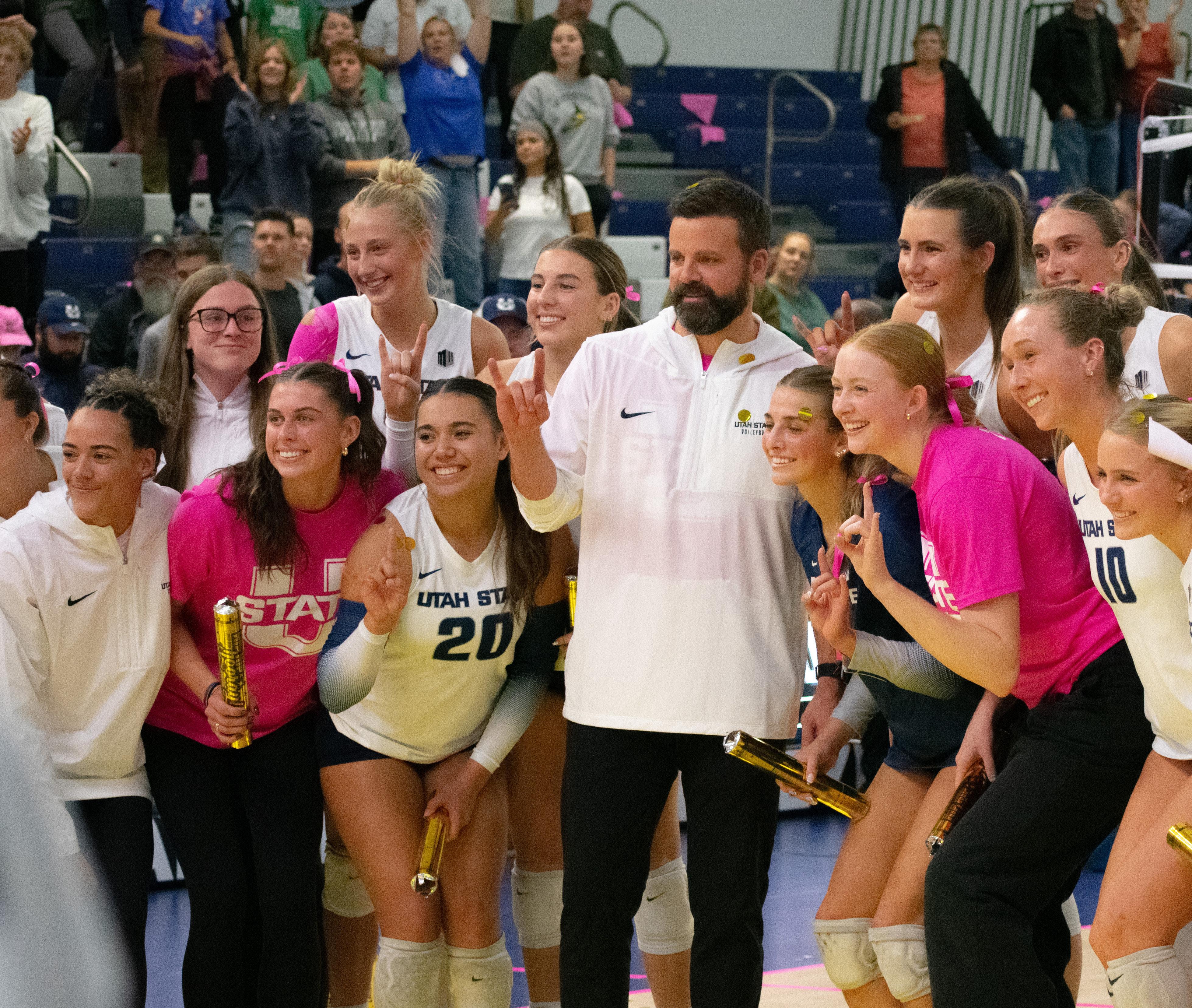



By Ella Stott STATESMAN EDITOR
USUSA Executive Council member Po’okela Yamakoshi-Sing, who served as the Logan vice president, was removed from office on Nov. 5 after a public conduct trial.
The trial took place at 10 a.m. in the TSC Maple Room under the direction of the USUSA Hearing Board, which consisted of students Amaya Strickland, Hal Searle, Jack DePouw, Miriam Smith and student chair Jarret Rupp. As part of his duties, Colin Hastings, USUSA student advocate vice president, served as the executive secretary to the board but was not present in the deliberation and could not vote in the ultimate decision.
A second public conduct trial regarding Ben Burdette, USUSA athletics and campus recreation executive director, will take place on Nov. 12 at 3 p.m., rescheduled from the original Nov. 7 date. At the time of publication, it was unknown where the rescheduled trial would be.
According to Yamakoshi-Sing, prior to the trial, he requested an extension for the hearing and that two board members be removed due to a conflict of interest, but both requests were denied.
In an email to The Utah Statesman, Hastings explained why this was the case.
“Hearing Board bylaws state that a trial must take place within ten days of a complaint, and his extension exceeded that timeline, and his reasoning for the extension did not fall under extenuating circumstances,” Hastings wrote.
As for the two removals, all student body officers, including Yamakoshi-Sing, were part of the nomination, vetting and voting process for the hearing board, and each member passed unanimously. Neither member Yamakoshi-Sing requested to be removed felt they had a conflict of interest or chose to recuse themself.
“His request to remove both was looked into by myself and several members of the faculty, however we found no conflict of interest, and did not believe that his reasoning met the threshold for removal,” Hastings wrote.
Student Body President Brandon Sorensen served as the claimant on the case, presenting evidence of YamakoshiSing’s conduct at the student event the Howl on Oct. 31. According to a police report, Yamakoshi-Sing arrived intoxicated to the Howl and provided misinformation to police officers when questioned about his identity and intoxicated state.
The trial started with a call to order and a presentation of evidence from the complainant and then the respondent Yamakoshi-Sing.
In Sorensen’s presentation, he distributed evidence via a GRAMA request of a Utah State University Police Department report from the Howl, which detailed police officers approaching Yamakoshi-Sing, determining his intoxication and questioning his identity, which he originally presented falsely.
According to Sorensen, Yamakoshi-Sing’s conduct broke both the USUSA Oath of Office, where officers promise to “uphold the Student Code and policies of Utah State University,” and the USU Student Code of Conduct, which
identifies “use, possession, or distribution of alcoholic beverages (1) in an unlawful manner or (2) on campus or during a university program or activity, unless otherwise permitted by the University” as well as “making false statements, whether oral or written, to University officials or law enforcement officers or otherwise providing information or identification known to be false” as student misconduct.
According to the USUSA Constitution, “Any officer found to be in violation of their Oath of Office by the Hearing Board may be place on probation,” and “Any officer who fails to remain free from any active USU Student Code violations that result in a sanction of probation or higher will be removed from office immediately with no option to appeal.”
In his closing remarks, Sorensen asked the board to consider the evidence with fairness and empathy.
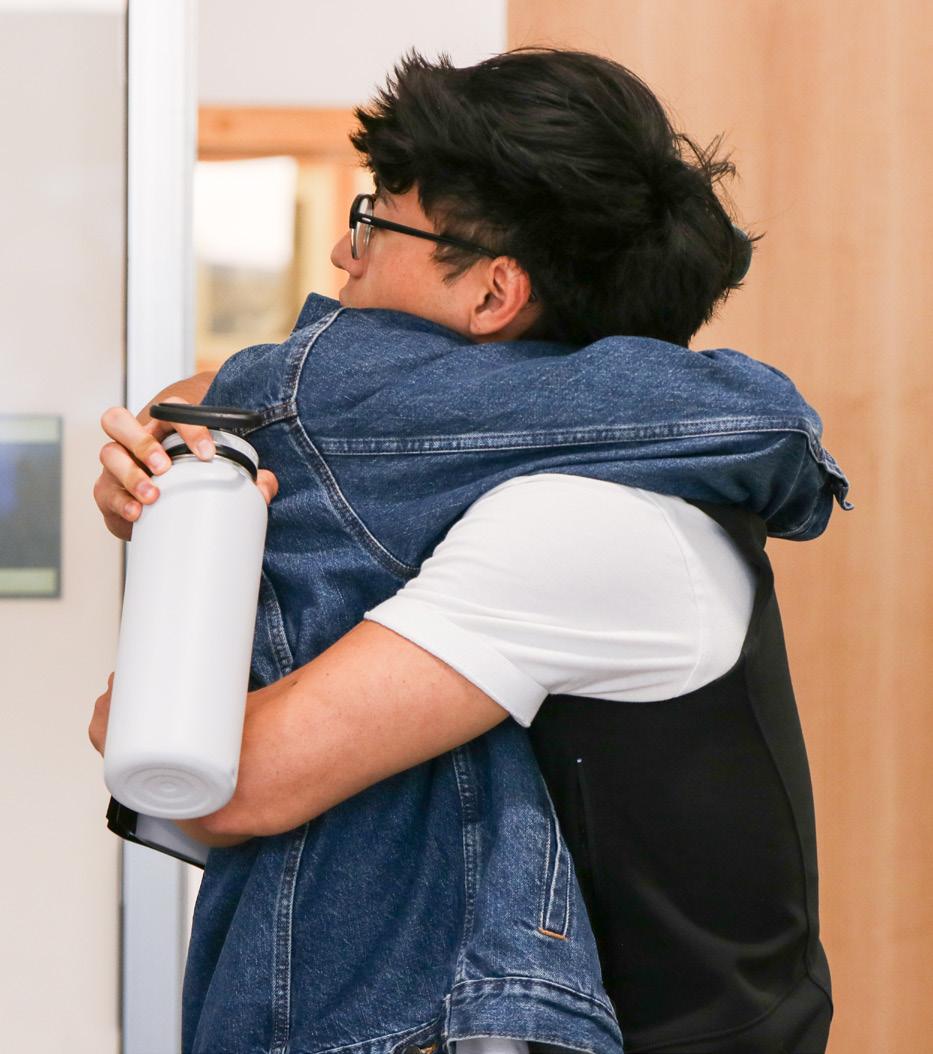
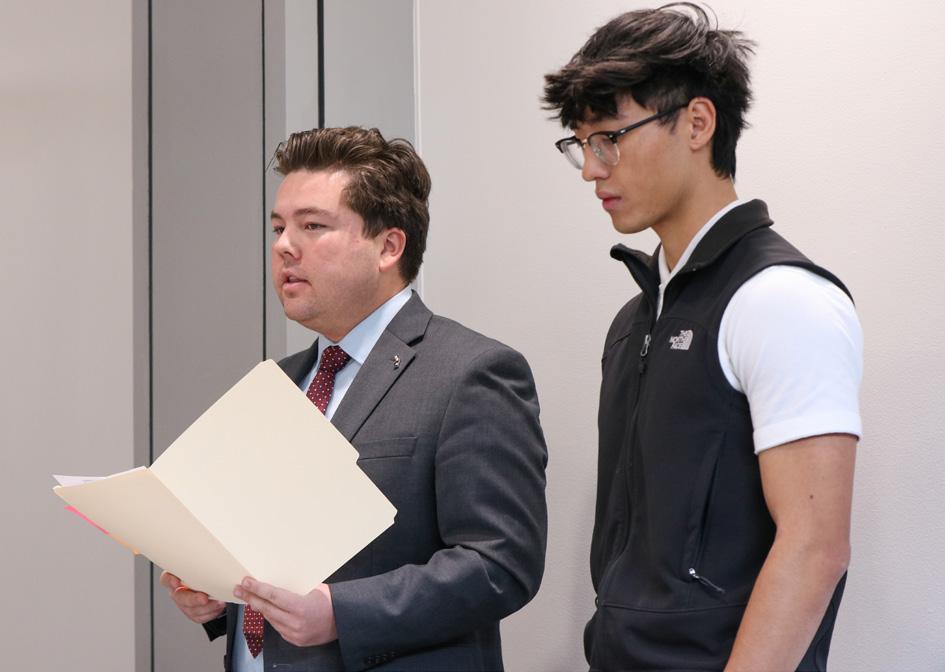
explaining his lie to the police officers about his identity derived from the fact that he didn’t want to represent USUSA in a negative light.
“Since the incident, I have immediately prioritized genuine self-reflection. I started by rebuilding what I broke in USUSA. I am working to understand the impact alcohol can have on professionalism,” Yamakoshi-Sing said. “It was an isolated mistake and does not reflect my core character. I believe in USUSA’s mission.”
Following Yamakoshi-Sing’s remarks, he called up two witnesses.
The first, a friend of Yamakoshi-Sing, accompanied him to the Howl and confirmed his timeline of events.
The second, a member of the Logan Vice President Committee, served as a character witness, stating “He cares a lot about the students at USU, and I can tell that he wants to make a difference, and he is making those actions to do that. I really appreciate him, and he inspires me in only positive ways.”
Following their remarks, the board went into a private deliberation, which lasted over an hour. When they returned after 12 p.m., Rupp announced the final verdict.
“Po’okela Yamakoshi-Sin violated the USUSA Constitution and failed to uphold Oath of Office and violated the Student Code of Conduct. As a hearing board, we have determined to remove Po Yamakoshi from his position as USUSA Logan vice president,” Rupp said.
“I want to express my respect and the work our Logan vice president has done — for the time, effort and care he’s given to serving Utah State. None of this should be overlooked or dismissed,” Sorensen said. “At the same time, the foundation of leadership within us, USUSA and within the university community rests on accountability and consistency. Whatever outcome you determine, I trust it will both uphold compassion for the individual and integrity of USUSA as a whole.”
After Sorensen yielded his time, Yamakoshi-Sing was called to present his evidence to the board.
“I want to offer my sincerest apologies for my lapse in judgement,” Yamakoshi-Sing said. “I am here to take full responsibility.”
Yamakoshi-Sing admitted to the charges against him, clarifying his course of actions through the night and
In an official statement from USUSA public relations director Abby Murcray, it states, “USUSA expects all officers to follow the bylaws outlined in the USUSA constitution. We want to thank Yamakoshi-Sing for all he has done for the organization and all the time he has committed to USUSA and Utah State University as a whole.”
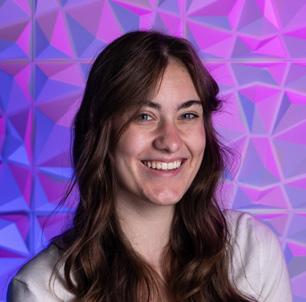
— ella.stott@usu.edu
Hi, everyone! My name is Halle Hart, and I’m so excited to be serving as the current senator for the College of Education and Human Services at Utah State University. I’m from a little town called Liberty, Utah. I’m also the youngest child with four older brothers.
I recently graduated with my undergraduate degree in recreation administration with emphases in event management and sport management, and I absolutely loved it. After graduating in the spring, I came right back to Utah State to start my master’s in sport management, and I currently work as a marketing intern with Utah State Athletics, which has been a very rewarding experience.
Outside of school and being a senator, I love playing sports, scrapbooking, going to USU events, cheering on the Aggies at athletic events, exploring new places in Cache Valley and spending time with my nieces and nephews.
As the CEHS senator, I have the opportunity to represent the students in our college and advocate for their needs, ideas and experiences.
I oversee the CEHS Council, which is made up of students who help plan events, service projects and initiatives that strengthen our college community. My council has different committees that focus on events, service and outreach and statewide engagement to make sure all CEHS students, including those on statewide campuses, feel supported and included.
During my time at Utah State, I’ve had the chance to get involved in a lot of different areas on campus. I spent two years with the A-Team as an orientation leader, two years helping with USU Student Events and two years as a Connections peer mentor. I’ve also served as an Aggie Blue facilitator, competed in the Miss USU

Pageant and joined Kappa Delta Sorority. Now, I’m proud to be serving my second term as CEHS senator. I first ran because I wanted to make a difference for students and make sure their voices were heard, and I’ve loved every minute of it. Working closely with the CEHS dean’s office, our associate dean and my council has helped me grow as a leader and shown me just how much of an impact genuine connection and collaboration can have.
One of my favorite quotes is, “Kindness is a gift we can all afford to give.” I think about this quote a lot in my role as senator because kindness really is at the heart of leadership. Whether I’m sitting in a meeting, planning an event or talking with students about their experiences, I’ve learned being kind and taking the time to listen can change everything. You never really know what someone else might be going through, but you can always choose to be understanding, smile at someone in the hallway or check in on a friend. Those small moments of kindness are what build the kind of community I love being part of here at Utah State.
I’m also so excited to invite everyone to CEHS Week, happening November 10-14. We have so many fun events planned. On Monday, we’ll kick off CEHS Week with a CEHS Snacktivity and Emma’s Jewels Escape Room. On Tuesday, we’re partnering with the Veterans Resource Office for their Veterans BBQ and a thank-you board for students to sign. Wednesday will feature an education fair with the Career Design Center and a tailgate with the HURD before the men’s basketball game. On Thursday, join us for Paints and Pastries Night, where we’ll be painting vinyl records and enjoying some sweet treats. Finally, on Friday, we’ll wrap up the week with Breakfast with CEHS, giving out donuts and muffins to students. We have so many exciting projects ahead of us this year, and I can’t wait to see what we accomplish together.
If you ever want to chat or share an idea, or if you have a concern, my office hours are Mondays from 10 a.m.-12 p.m. and 2-4 p.m. in TSC 335, Tuesdays from 11 a.m.-2 p.m. in TSC 335 and Fridays from 10 a.m.-1 p.m. in the Emma Eccles Jones Education Building conference room. I would love to meet you and hear your thoughts about how we can make CEHS even better. I’m so grateful for the opportunity to represent the College of Education and Human Services for the second year in a row, and I’m so proud to be an Aggie. As always, Go Aggies! — cehssenator.ususa@usu.edu

By Kenadie Jackson STATESMAN REPORTER
Utah State University Facilities added a new garden to Logan campus.
Located between the Merrill-Cazier Library and the cience Engineering Research building, this new garden is a large ellipse of stone benches surrounding a tree. Tucked to the side is a smaller circle of the same stone benches. With wooden arch entry points and a variety of vegetation, this garden is meant to be “used as a space set apart from campus to feel a little bit more private and secure but still within campus,” according to Nate Christiansen, designer and builder of the garden. This garden is here to stay, according to Christiansen. “We hope it will be there forever. There’s a good opportunity, and it’s kind of off the beat,” Christiansen said. “We wanted that location because there probably won’t be any buildings going in there, so hopefully it can be there for years and years to come and have the trees healthy, old and established.”
Shane Richards is the landscape operation and maintenance manager for USU Facilities.
“We asked ourselves, ‘What could we do to replace the willow structure and put something neat there?’ We brainstormed and decided that this little sitting area was perfect for that kind of spot,” Richards said. This garden is made up of spaces to sit and commune, but there is also a diversity of plants.
“Outside the fence will be for color, but everything inside the fence will be things that you can discover or learn in a garden. We’ll have lots of edible plants in there — hopefully lots of fragrances and bright colors,” Richards said. “We’ll have some peach trees, some pear trees. We have some grapevines, and we’ll be doing
some raspberries.”
The trees and plants there have not bloomed yet, which is part of why Christiansen hopes the garden is here to stay.
“The trees will probably start to be established in three years. We then will have some different annuals that come and go, and those will be ready next year, then some different perennials that will hopefully also show next year,” Christiansen said.
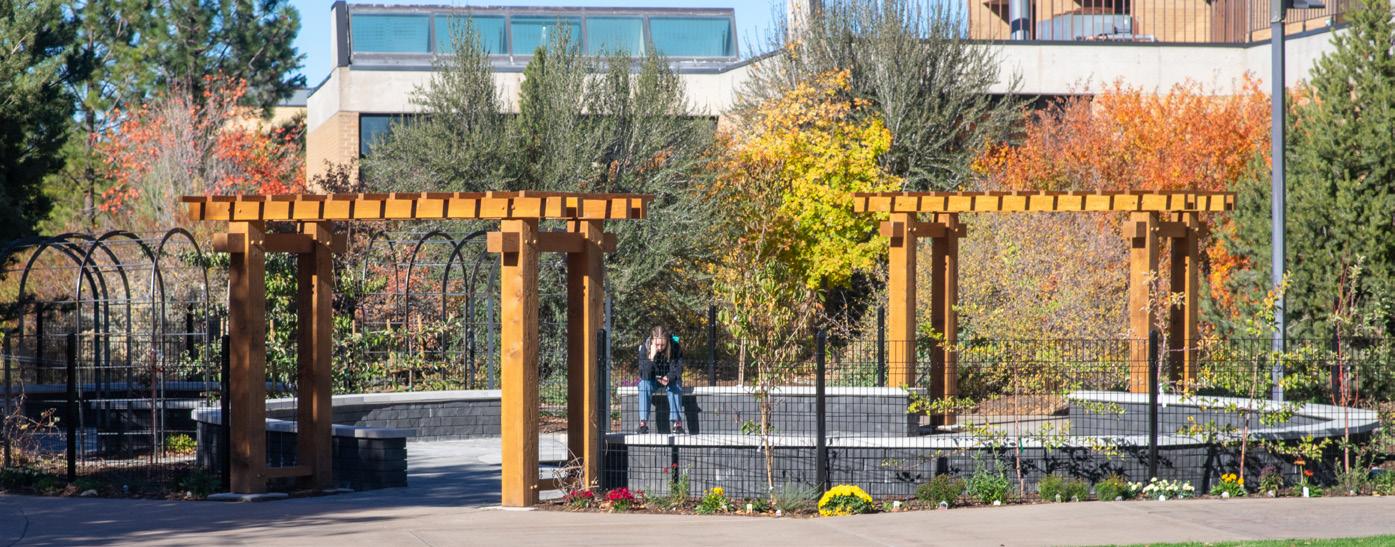
According to Richards, the variety of plants and gardens at USU may go unnoticed, but that is partially the point of them.
“There are several different theme gardens that we have throughout all of campus, and we don’t label them. We’re just hoping that people can discover them, enjoy them, perhaps even wonder what they are,” Richards said. “We’re constantly thinking about spots that we can actually do to make it a little more fun for the students and for the faculty.”
These gardens are each part of a different landscape plan. According to Richards, USU plants 5,000 bulbs each year and 60,000 annual flowers.
“We order up the bulbs every spring, get them every fall, and then we plant them everywhere we can on campus. We have quite a few deer, so a lot of them get sacrificed to the deer, but we do have these magical spots where the deer don’t go,” Richards said.
The annual flowers are grown and protected in their greenhouse.
“We maintain the irrigation system. We maintain the turf as far as fertilizing, mowing, weed control and insect control,” Richards said. “We maintain the beds, and we’re always planting the flowers.”


— kenadie.jackson@usu.edu
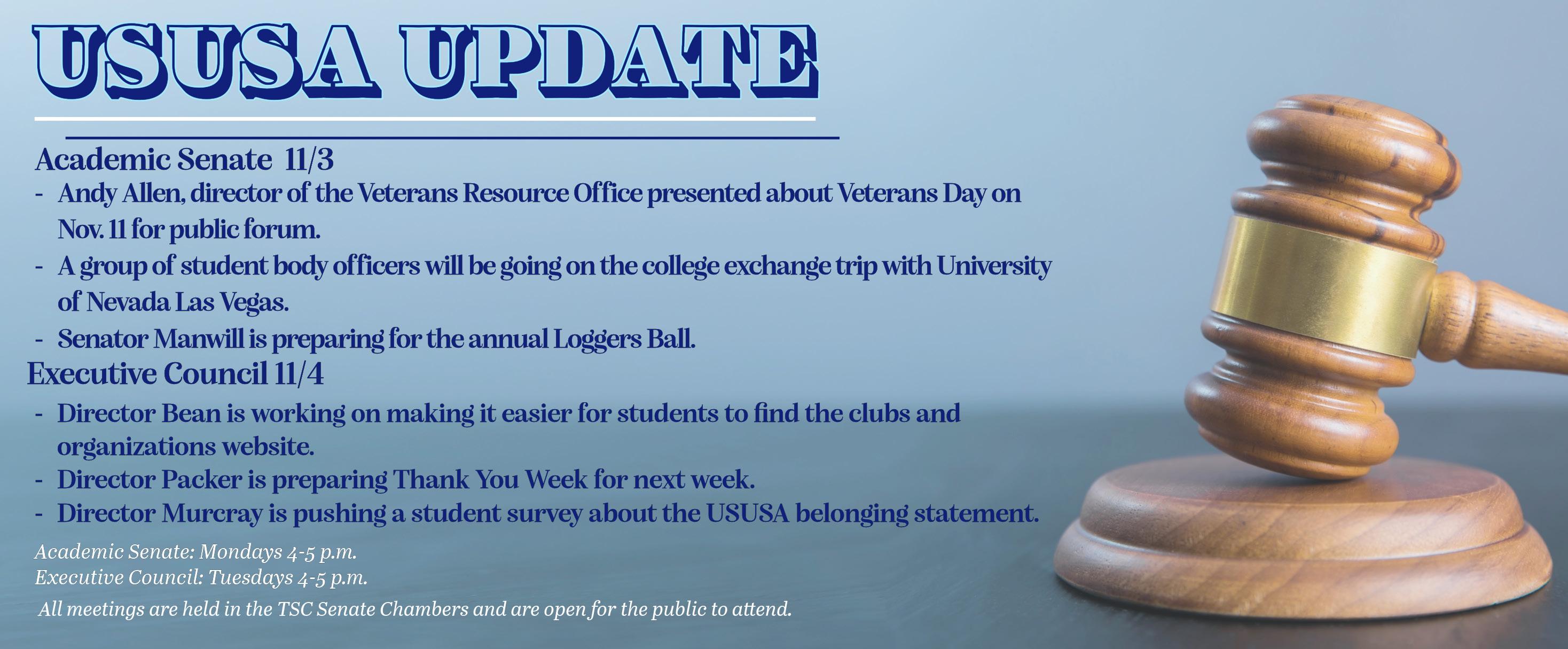
By Mia Nielsen STATESMAN REPORTER
Cache County Sheriff Chad Jensen and Logan City Police Chief Jeff Simmons met with members of the Cache Valley community at the Logan Library to discuss immigration control and U.S. Immigration and Customs Enforcement’s relationship with Cache County.
On July 31, Cache County entered the 287(g) program, establishing a formal relationship with ICE. Several attendees of the Q&A on Oct. 30 expressed concern about the county’s relationship with ICE. Public comments reflected appreciation for local law enforcement but fear of federal overreach and concern for friends and family.
Jensen emphasized the agreement would not majorly change existing procedures. The 287(g) program includes three models, and Jensen chose the least invasive, the Warrant Service Officer agreement.

Under this model, immigration status is checked only after an individual is booked in jail, a process already required by state law. If the individual is unable to prove legal residency, ICE has 48 hours to decide whether they should be held. So far, ICE has put a hold on seven individuals and arrested two in Cache County.
The agreement also authorizes a small number of deputies to access federal immigration databases and verify an individual’s status once they complete a training. So far, no deputies have been asked to complete the required training.
Jensen said signing the agreement demonstrated “a level of cooperation” that has strengthened the department’s relationship with ICE. This year, ICE notified him
both times they entered the county to make arrests — something he noted hadn’t always happened in the past.
Many attendees voiced concerns the agreement could lead to ICE overreach, but Jensen does not plan to extend the county’s current agreement with ICE.
“You have my word. It’ll never go past what we’re doing right now,” Jensen said.
He added if ICE agents were to break the law, he would arrest them just like anyone else.
Nicole Allen, a professor at Utah State University, is one of the representatives working with Raíces Cache Valley, a local immigration support group that helped facilitate the Q&A. She noted this has been a time of significant stress for members of the immigrant community. Allen believes fear kept many people from attending the Q&A, so they collected questions both before and during the event and plan to release a report.
“Some people know that they’re in the system. They’re doing exactly what they should be doing. They still wake up every day fearful that a parking ticket or a noise complaint, which we know happened down in Salt Lake City, will wind them up in ICE detention,” Allen said.
Allen said people generally trust local law enforcement but are afraid of the federal government. She thinks statements, like Jensen’s promise to hold ICE accountable if they broke the law, do a lot to reassure the community.
“Logan City Police and most city departments around the state are operating exactly as we have. Despite what happens at the national level, our focus is on public safety,” Simmons said.
Logan City Police does not have the authority to enforce immigration law, and Simmons said officers will not ask for immigration documents during traffic stops or participate in immigration sweeps.
“The most important thing to know is that we want victims and witnesses of crimes to be safe when they call Logan City PD,” Simmons said. “Your immigration status will not be asked for or shared.”
Jensen also listed public safety as his top priority, saying Cache County deputies will never ask for immigration status on the side of the road or in someone’s home.
“I don’t want anybody in our community to ever feel that they can’t report a crime or not feel safe because of their immigration status,” he said.
Jensen believes most detainees will not be held by ICE due to the lack of jail capacity in Utah. As of six months ago, he estimated there were only 300 beds available in jails statewide, meaning that so far, ICE has chosen only to pursue individuals who pose a genuine threat to public safety. However, ICE has the authority to operate anywhere in the county, including on Utah State campus.
Several attendees said police policies and promises have not always matched their personal experiences. Several mentioned problems with the county sheriff’s blotter and the difficulty of finding people after they have been arrested.
Allen said there is an informal network that shares information when someone in the community has been detained by ICE.
“One of the things that we try to do is just figure out where these people are. This summer, we knew that
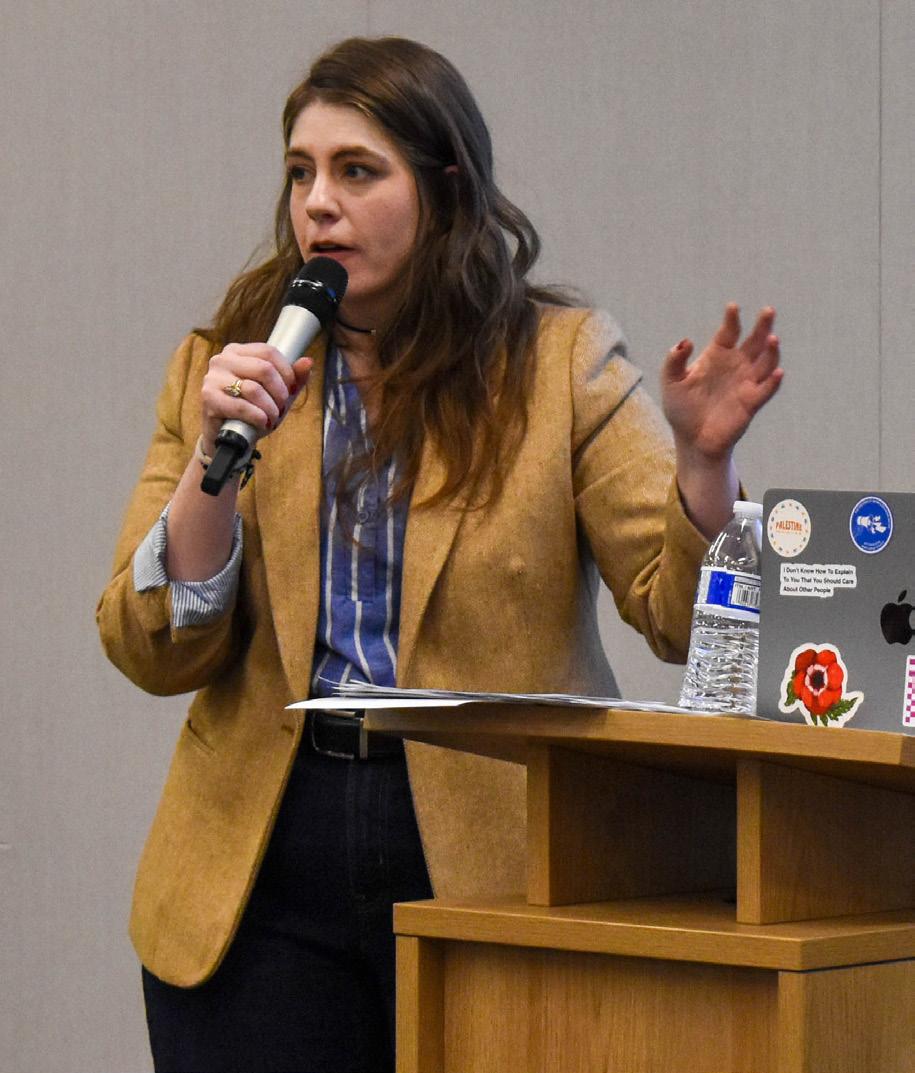
there was a person who was detained, but for 48 hours, we weren’t able to find them. I called the county sheriff’s office. I spent quite a bit of time talking with them, and they just didn’t show up,” Allen said after the event. Both Jensen and Simmons encouraged residents to bring their testimonies and concerns to their departments.
“If somebody feels like a policy was not followed, contact me directly,” Jensen said.
Jensen and Simmons asked citizens to contact their offices directly if an officer asks a question about immigration status during something like a routine traffic stop. Members of Logan City Police wear body cameras, and Simmons said if a complaint is filed shortly after an incident, the department is happy to review the footage.

Mia Nielsen is a sophomore studying plant science and journalism. When she’s not writing, she enjoys live music, driving up Logan Canyon and daydreaming about moving to Spain.
—mia.nielsen@usu.edu


By Dylan Moore STATESMAN REPORTER
Utah State University’s aviation program is raising the bar for pilot and air traffic control training with the addition of two new simulators, according to aviation student Liam Pokorny. The new simulators are a Boeing 737-NG Flightdeck and an advanced air traffic control system, both designed to bring real-world aviation experience into the classroom. The simulators, installed earlier in the semester, are already being used by students in the aviation technology and air traffic control programs. The new equipment, part of a multimillion-dollar investment in aviation education, replicates real flight and communication environments with the same software used in professional airline and Federal Aviation Administration training facilities.
Captain Parry “Pee Wee” Winder, jet training lead instructor for the aviation program, said the new simulator gives students the chance to train like commercial pilots before entering the industry.
“It’s a flight simulator fully enclosed with a 220-degree view,” Winder said. “Once they master the systems, they can come in here and do a full flight from
point A to point B. We never freeze. We never pause. We just treat it as airline pilots.”
The simulator mirrors the exact flight deck layout of a Boeing 737, complete with functioning instruments, control feedback and full automation. The only difference from commercial airline simulators, Winder said, is USU’s version doesn’t have hydraulic motion legs that allow the simulator to tilt or turn.
Before entering the 737 simulator, students work through several training stages, including systems instruction and computer-based automation modules. Once proficient, they progress into the cockpit, where everything they’ve learned comes together.
“Think of the other simulators like puzzle pieces,” Winder said. “When students get in here, it all comes together as a complete picture.”
During a demonstration, an aviation instructor guided the simulator through a flight from Salt Lake City to Logan, showcasing the software’s realism. Students can program global airports, simulate standard operating procedures and practice emergency situations ranging from flap failures to engine fires.
The program runs nearly around the clock, with students and instructors volunteering time between 5-12 a.m. six days a week. Winder said none of the instructors are paid for their simulator time. They volunteer to gain experience and improve their skills as they prepare for airline careers.
While the flight simulator focuses on aircraft operation, USU’s new air traffic control simulator gives students insight into what happens on the other side of the radio.
Aaron Whittle, a professional practice assistant professor and former air traffic controller, said the new
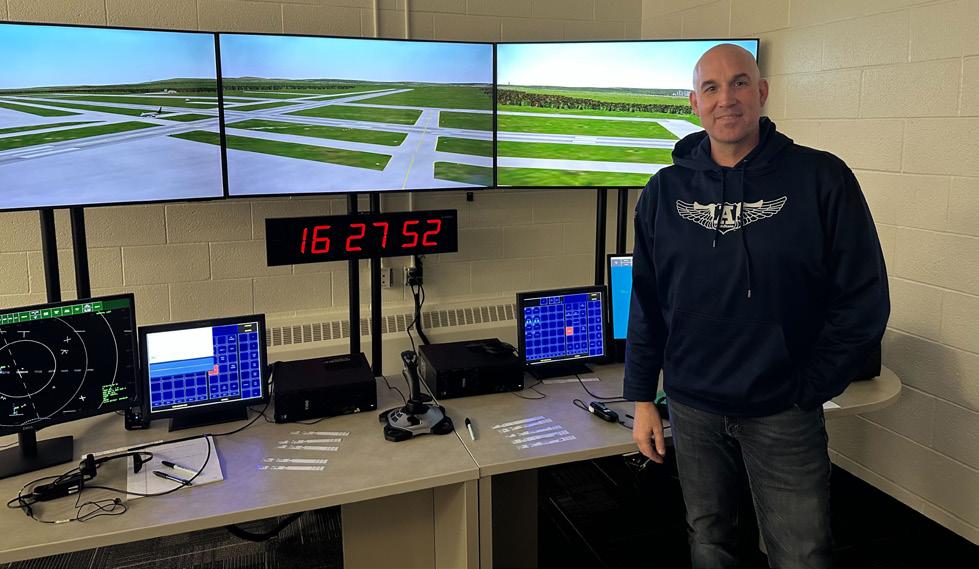
system brings realism that goes beyond textbooks or radio drills.
“This really takes it to the next level,” Whittle said. “Students can talk into the computer, and the computer talks back to them. They can visually see the airfield, aircraft moving, and hear real radio chatter.”
Whittle said the simulator mirrors the FAA’s training layout, helping students learn the same procedures used by professional controllers.
“If our students ever want to go to the FAA, they’ll step into that schoolhouse already familiar with it,” Whittle said. “It’s exactly what they use to train their controllers.”
The simulator includes both 2D and 3D environments. Students start with tabletop exercises before transitioning into a fully immersive tower view, managing multiple aircrafts at once. The technology recognizes aviation phraseology, requiring precise wording for commands to register correctly
According to Whittle, the experience helps pilot students gain a deeper understanding of how controllers work under pressure, improving coordination and safety.
“They gain a whole new appreciation for what’s going on inside that control tower,” Whittle said. “When they get back in the cockpit, they better understand why a controller might not answer right away.”
For students like Pokorny, a senior in the professional pilot program, the simulators have made a clear difference in confidence and readiness.
“These definitely help us stay ahead of the aircraft,” Pokorny said. “We fly two or three times faster in the simulator than we do in the plane, so it trains us to think faster and be more prepared.”
Although the simulator hours can’t count toward FAA flight requirements, they carry weight with airlines.
“I can’t log it as flight hours, but when I go to an interview and tell them I’ve flown 50 hours in a 737 simulator, they know I understand how to fly,” Pokorny said.
With both the 737 and air traffic control simulators now in place, USU’s aviation program has positioned itself as one of the most advanced collegiate flight schools in the region. USU’s flight school is ranked No. 18 in the nation with over 1,000 flight schools in the U.S.
“These systems are exactly what’s used in the industry,” Whittle said. “It’s helping our students step into the real world already knowing what to expect, and that makes all the difference.”
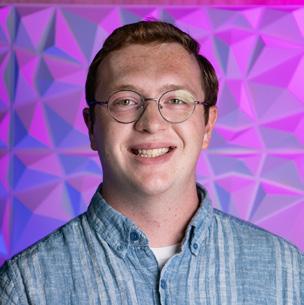
Dylan Moore is a junior majoring in political science and minoring in anticipatory intelligence and Russian. He always loves going on outdoor adventures and cooking. — dylan.moore@usu.edu

By Rory McNeill STATESMAN REPORTER
Students and faculty met in the Evan N. Stevenson Ballroom in the Utah State University TSC on Nov. 3 to celebrate students who are blazing new trails for themselves and their families. The Aggie First Scholars program held its annual “I Am First Banquet,” which featured multiple guest speakers, highlighted by keynote speaker Alan L. Smith, interim president of USU.
AFS is designed to unite first-generation students to help them navigate their college education. Along with creating groups to support one another, the program offers multiple scholarships to help members along their journey. The banquet provided an opportunity to celebrate those first-generation students across campus.
Sophomore Hayden Walker, student coordinator for AFS, highlighted how important it is to have a group on campus where first-generation students can meet and give each other support to face the challenges of college.
“It’s crucial to have a group like this. From my personal experience and from other people’s stories that I’ve heard, as first-generation students, we come into college with no idea what to do because our families haven’t had experience with it before,” Walker said. “Aggie First Scholars was like a home to me because it taught me how to study, and it taught me how to be a successful student. Also, hearing other people’s stories as well helped build that community where I felt that I do belong here.”
To begin the event, multiple students in AFS shared small thoughts and notes about the program. This included one student’s poem about her unique experience of having autism while in school, and
another student highlighted the accomplishments of the program over the course of the past year.
Following the introductory remarks, the time was given to the Smith, who shared his own story of being a first-generation student and learning to navigate through school. Throughout his speech, he highlighted various lessons he learned across his journey, starting from his athletic career to his focus on academics.
According to Smith, being a first-generation student requires strength and resilience, since students are in a setting others in their family haven’t been in before.
“Own your own story,” Smith said. “That should be a great source of belief in yourself. Carry that forward.
Don’t be afraid to fail forward. It is through failure that we learn deeply, and realizing your potential is about pursuing challenges and learning from them.”
He also emphasized the importance of risk-taking throughout college and pushing one’s limits to find out how far they can go.

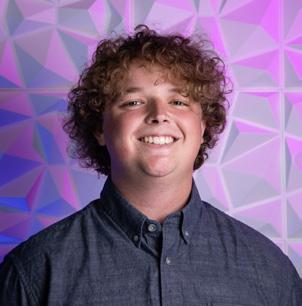

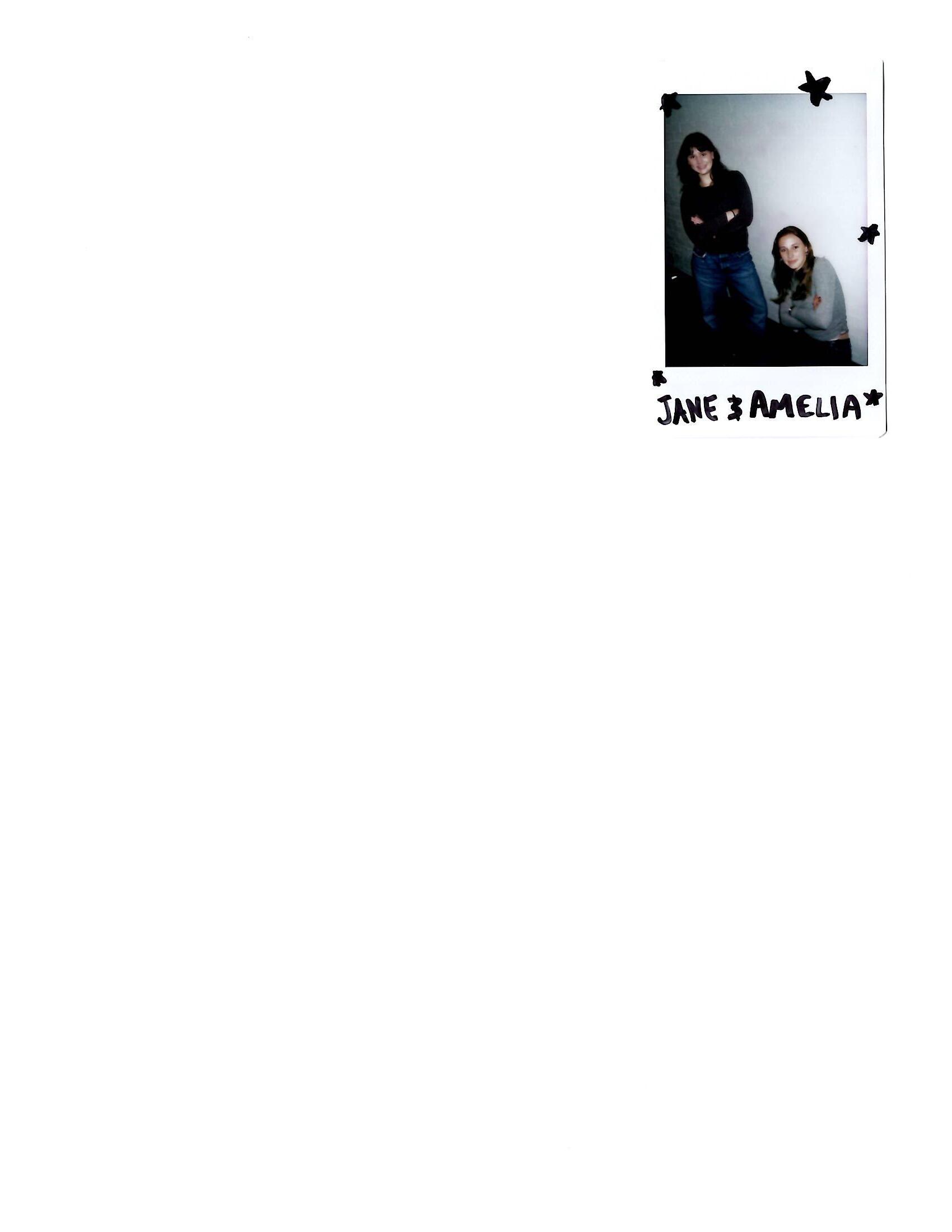



By Essence Barnes STATESMAN REPORTER
Drums and song echoed through the Utah State University Mehdi Heravi Global Teaching and Learning Center on Nov. 4 as students, staff and community members came together to celebrate Native American Heritage Month with a first-of-its-kind event.
The Native American Heritage Day event was put on by USU’s Center for Community and the Native American Student Council. This celebration welcomed Indigenous leaders, educators and dancers, as well as other local organizations, to come and share the history and culture of the Native Nations.
Faustine Saganey, program coordinator of the Center for Community, said her past experience at USU as a former vice president for the council and as Miss Native American shaped how she integrates culture and community connection on campus.
“The Center for Community’s mission is to support student engagement through educational programming and shared experiences,” Saganey wrote in an email to the Utah Statesman. “The event intended to offer a shared learning environment where students could gather, engage with cultural history, and connect as a campus community.”
The event began with an honor song by the Scout Society, a drum circle group who performs at powwows, drum circle competitions and other Indigenous-based events across the United States.
The opening honor song was followed by keynote speaker Melissa Tehee, associate professor of psychology at USU, and honored guest Jason Walker, chairman of the Northwestern Band of the Shoshone Nation.
Tehee spoke on the importance of recognizing USU as a land-grant institution built on Indigenous land and shared a few lines from the universities first land acknowledgement officialized in 2021.
“We acknowledge that USU and all in-state USU

Institutions reside on the original territory of the eight federally recognized Tribes of Utah,” said USU in its land acknowledgement. “We acknowledge the painful history of genocide and forced removal from this land, and we honor and respect the Indigenous peoples still connected to the land on which we gather.”
Walker shared stories from his experience as a former student at USU and as an active leader in his Indigenous community, describing how being a leader is all about recognizing and being proud of who and where you come from.
“The way students listened and engaged with both speakers stood out as one of the most impactful parts of the day,” Saganey wrote.
Refreshments were provided in the form of native Navajo frybread and chili. Guests were also invited to explore different outreach tables detailing various aspects of Native American culture, including sheep raising, weaving and herb bundling.
The herb bundling table was put together by the Urban Indian Organization of Salt Lake, the only UIO nonprofit in Utah, which provides health and social services to Native Americans living in urban areas and beyond.
Honey Duvall, a representative from the UIO, taught attendees the benefits of traditional medicine in Native culture through a hands-on herb bundling activity.
“There are various different kinds of medicines we use in our community,” Duvall said. “All different tribes utilize a specific medicine.”
Duvall said sage and cedar are some of the most commonly used herbs in Utah and are honored within Indigenous communities for their various spiritual and physical healing properties.
“You give a traditional medicine, and it holds an even higher respect than monetary gains,” Duvall said. “When someone gives you something like this, they honor you, but they also appreciate the work you’re doing in the community and the greatness you have to provide for everybody out there.”
The event included three different traditional Native dances including the hoop, fancy, jingle and round dances. Each dance told a different story and represented a unique traditional aspect of the Native community, and many attendees commented that those performances were some of their favorite parts of the day.
“The closing round dance was the moment that stayed with me,” Saganey wrote. “The round dance is a social dance often seen at powwows and community gatherings — it’s simple, welcoming, and meant for everyone to join. Students, staff, faculty, and guests stood side-by-side, holding hands and moving together in a slow, steady circle around the room.”
According to Saganey, feedback on the event from both Native and non-Native students was incredibly positive. “Many people mentioned how engaging the tables were — especially the archival materials, cultural education displays, and hands-on demonstrations,” Saganey wrote.

“Several attendees told us they stayed longer than they planned because they wanted to continue learning and participating.”
Lyneah Israel and Cynthia Tsosie, two Native American students at USU, said attending the event was an opportunity to reconnect with their homes and families while being up at school.
“The Native population here is less than 1%, so it’s really hard to find people to connect with,” Israel said. “It’s really nice to have a taste of home from here.”


By Katie Smith STATESMAN REPORTER
Tucked behind Aggie Ice Cream and the Nutrition, Dietetics, and Food Sciences building, members and visitors of Utah State University Sustainability Club gathered to clean up the university’s permaculture garden. The permaculture garden provides Aggies with a sustainable way for gardening using native Utah plants and natural pesticides.
“Permaculture takes indigenous knowledge and ecological methods and tries to mimic the closest it can a natural ecosystem,” said Natalia Bustos, an intern working at the garden.
The garden uses methods that model a natural growth process to ensure the most sustainable produce. Because

Maddy Guillory, club vice president, said she wanted those attending the event to leave with tools for how to implement sustainable living into their lives.
“I think it would be really awesome for them to get handson experience with different ways to live sustainably,” Guillory said.
The event was organized in hopes to familiarize USU students with the permaculture garden and reached not only students but even some members of the Logan community.
Those who came to the event volunteered to clear most of the vegetation in preparation for winter. After everything was cleared, the group was left with a large pile of roots, stems, leaves and more. In true sustainable fashion, members of the club gathered the remnants to be transported to the Utah Conservation Corps. The corporation accepts these leftovers and composts them at its facilities.
“I wanted to do an event that would first of all increase awareness of the permaculture garden and be somewhat educational but also a service project so we could help and be actively doing something,” Smith said.
This was the first time the club collaborated with the permaculture garden.
“It’s not very well known among the general student body,” Smith said.
Leaders of the club and permaculture garden want students to know the garden is more than a decoration
Find most of these ingredients at SNAC!
Ingredients
3 large eggs
¼ cup canned spinach
¼ cup carrots (diced or thinly shredded)
¼ cup bell pepper (diced)
2 Tablespoons Milk
⅛ cup onion (diced)
Shredded cheddar cheese
Salt Pepper
Butter/Cooking oil
Instructions
Prepare Veggies: Chop and shred spinach, carrots, bell pepper, and onion as desired.
Sauté: Heat a skillet over medium heat Add apx. 1 tablespoon of cooking oil or butter.
Sauté all veggies except spinach till soft (Around 5 minutes) Add spinach and cook for an additional minute
Cook Eggs: While veggies are sauteing, whisk eggs, milk, salt, and pepper in a bowl Pour into pan over sautéed veggies and scramble until cooked through Enjoy: Top with cheddar cheese and enjoy!
— it is there as a tool for students. The garden offers more than a relaxing environment. It also provides fresh produce for Aggies.
“Students can get fresh and organic produce that is literally coming from 10 minutes away,” Bustos said. Produce from the permaculture garden is available for students to take not only for ingredient use but for labs and experiments, Bustos said.


Katie Smith is a sophomore still exploring her options at Utah State. She is a big country music fan and loves spending her time in Cache Valley’s beautiful natural landscapes.
— katie.smith@usu.edu
In collaboration with Utah Food Bank and Cache Community Food Pantry, SNAC launched Cache Valley’s first-ever Mobile Food Pantry: a monthly food distribution event that focuses on providing fresh produce and other perishable items to USU students and members of the community This initiative will continue to operate on a monthly basis, offering ongoing food assistance to those in need throughout the community
Since its launch in May, the mobile pantry has distributed over 55,800 pounds of food to over 850 families in need in Cache Valley
The next distribution dates are November 11 and December 9 , from 9 - 10am in the Maverik Stadium parking lot. th th



By Sam Isaacson STATESMAN SENIOR REPORTER
The Utah State University Small Enterprise Education and Development internship program hosted its first SEEDxp competition, which challenged students to solve a real business problem one of SEED’s international partners has. The case was introduced to the teams of students on Oct. 21, and the teams presented their solutions on Oct. 28 to a panel of judges.
Each person on the winning team received $1,250 to help pay for a two-week SEED experience in Mexico. Isaac Peterson, graduate student in engineering at USU who helped design the case, said they based this year’s competition on an individual named Luis — who sells nuts in Merida, Mexico — that he and other students worked with during their study abroad internship over the summer. Andy Thunell, program coordinator for the Center for Entrepreneurship and SEED internship manager, and Michael Glaser, executive director of the center, visited the students in Mexico while they were teaching Luis, which inspired the idea.
“[Luis] had a lot of passion for his business, but he had some problems that were really hard to overcome,” Peterson said. “So, the vision for SEEDxp was to come up with real, actionable ideas that people in the future could go and present to Luis and actually have him apply them in his business.”
Isaac Low, junior studying finance, was one of the members on the winning team. He said they had three solutions they came up with for the case. Their first solution was focused on having him offer a unique opportunity for customers.
“So, the problem Luis was running into was he couldn’t increase his production, nor did he want to outsource the labor for producing his nuts,” Low said. “He also didn’t want to raise his prices either, which makes it really hard to double the revenue. We decided one way he could double his revenue while not increasing prices or increasing production and adding extra labor would be through a culinary tourist experience. I’ve experienced this and seen it work in Italy, where people want to go and have an authentic experience watching someone cook.”
Low said the culinary tourist experience would have Luis cooking his batches of caramelized nuts while tourists could make a small batch for themselves alongside him. The second solution they came up with was to create small gift bags of Luis’ raw nuts and sell them to businesses like Airbnb.
“I experienced this as I went to Hawaii last fall. We walked in, and there were some macadamia nuts,” Low said. “Something super simple, but it made us really happy. Merida is filled with tourists and has thousands of Airbnbs. We thought something super easy would be selling these small bags of nuts to them.”


Natalia Capote, sophomore studying veterinary science and marketing, was also a member of the winning team. She said their third solution was to find ways for Luis to get his horchata into stores in Merida.
“They have a co-packer there called Valle Redondo, and basically, we would bring them his family recipe and the design that he wants to put in stores,” Capote said.
“The co-packer would then create his product, store his product and distribute it to Walmart and Oxxo, which are some pretty big companies.”
Capote said Luis is unable to afford the nutrition label required to sell in stores, and by partnering with the copacking company, he wouldn’t have to pay for it.
According to Thunell, they decided to start hosting this competition to give students new opportunities within the SEED program. The students who won the competition will have the opportunity to interact with Luis and a handful of other entrepreneurs during the two weeks they are in Mexico.


Sam Isaacson is a senior studying journalism with a double minor in art and psychology. She is passionate about human rights, animal rights and climate change.
By Jayke Martin STATESMAN REPORTER
When senior goalkeeper Taylor Rath transferred to Utah State University from Pepperdine University, she wasn’t just chasing a new opportunity — she was confronting fear.
“A little bit of fear and also just trusting that I knew in my heart I’d get the most player development out of Utah State,” Rath said in an interview with The Utah Statesman. “I was probably the most scared to come to Utah State out of my three schools, and it turned out to be the best decision I made, and I couldn’t have imagined going to another school or playing somewhere else.”
She said her fear pushed her to take a big step. Adapting to a new program and meeting new teammates was not easy. However, during her time with the Aggies, Rath has become a player recognized for her skill in games and her positive presence in the locker room.
“She’s brought a level of maturity that’s so valuable for us,” said USU Women’s Soccer head coach Manny Martins. “We have so many young players playing and getting established — to have a goalkeeper that is a bit more mature and has a lot of experience behind them just brought a lot of leadership and confidence.”
Rath, who spent the past three seasons at Pepperdine after beginning her career at the University of Texas at


San Antonio, admitted her journey has been anything but smooth. She’s faced injuries, transfers, bench time and moments of self-doubt. But every challenge, she said, has shaped her into the player she is today.
“Nothing has come easy in soccer,” Rath said. “‘I’ve gone through knee surgeries. I’ve gone through being benched. I’ve gone through just playing. I’ve gone through all the ups and downs of doubt, and I think that’s what keeps me wanting to push so far.”
According to Martins, her hard work shows on the field. During her 2023 season at Pepperdine, she recorded a 9-45 record, logging 1,560 minutes in goal with a 1.10 goalsagainst average and a .776 save percentage. These statistics helped earn her a spot on the All-Mountain West Second Team after transferring to USU.
Now, as one of the older players on the roster, Rath works to foster a strong relationship with her youngest teammates.
“I have those close relationships, and I’m always going to be an ear for them, whether it’s on the field, off it, spending an hour to dig out Summer Diamond’s car in the snow or jumping through the girls’ car windows,” Rath said. That attitude hasn’t gone unnoticed by her teammates or coaches.
“She’s definitely a good guide on and off the field,” Martins said. “She’s been a starter in other places, but she’s also been the number two, so all of that experience has helped her not only connect with some of the other players but particularly our goalkeeper union.”
For Martins, Rath represents the type of player USU’s program strives to recruit: talented but also selfless and grounded.
“Everything starts with the soccer pieces, right?” Martins said. “But then the character piece is so important for us — we pride ourselves on having a really strong culture. All it
takes is one personality that’s not a fit to ruin everything.” Rath credits much of her confidence to the support she’s found in Logan, both from her teammates and from the environment the coaching staff has built. According to Rath, she came to USU knowing that she’d have the best chance to grow — not just as a player but as a person.
“My goals were definitely to be heavily involved with the team, spend time with them and really just embody the culture and do everything for the team,” Rath said.
Rath takes pride in staying grounded, even with the pressures of being a student-athlete. Between practices, travel and academics, she said balance comes down to presence.
“Just put one foot in front of the other,” Rath said. “Be where your feet are. I have ‘carpe diem’ tattooed on me. It’s just being in the present moment, seizing the day.”
This mindset has helped her handle both the nerves before a big game and the challenges of everyday college life.
“You just have to jump,” Rath said. “You’ve got to go all in, and you can’t look back. Fear is the unknown. I have no idea what this is going to be, but if I don’t do those things that scare me, I’ll never gain the confidence to go out and do things in the world.”
That fearless approach is something Martins sees translating to the next level. He believes Rath has the talent and mentality to play professionally after graduation
“Taylor is definitely a future pro,” Martins said. “It’s definitely something that she wants to do. She’s got the qualities, the pieces, so we’ve been working on some of the details.”
For Rath, the dream is simple: keep playing soccer as long as she can.
“As long as my body will let me, I’ll keep going,” Rath said. “I love this game more than anything.”
While she’s focused on what lies ahead, she remains deeply grateful for all USU has given her: lasting friendships, confidence and an even stronger love for the sport.
“The grass isn’t always greener on the other side,” Rath said. “It’s greener where you water it, and the sprinklers have been on at Utah State.”

Jayke Martin is a junior studying journalism with a minor in theater. She loves reading and meeting new people.
— jayke.martin@usu.edu

By Mark Greenwood STATESMAN EDITOR
In sports, there are many repeatable processes and events that rely on preparation, repetition and focus where the opposing team has little to no impact on the process and outcome. Examples of such processes include free throws, field goals, serves and more. In this step-by-step series, we’ll take a hands-on approach to those repetitive, ritualistic elements of athletics to see what makes athletes successful and just how repeatable their processes are.
Utah State Football placekicker Tanner Rinker is 7-7 on field goal attempts this season and 27-28 on point-aftertouchdown, or PAT, kicks prior to the home matchup against Nevada. Rinker has played a pivotal role all season for the Aggies, including in their homecoming win over San Jose State in October, where he went 6-6 on kicks while hitting three key field goals and three PATs. “It was really cool,” Rinker said after the win over the Spartans. “I try to treat every kick like the same, so no matter the context of it, it’s got to go through. So that’s just my mentality.”
Head coach Bronco Mendenhall echoed the importance of Rinker’s performance in his press conference the following week.
“It changed the game,” Mendenhall said. “Just really fun to see someone go out and in the moments where they’re called on to do their job for the team, to have success.”
To kick off the first piece of this series, I met with Rinker after a USU Football practice to see just how difficult those kicks are and have Rinker teach me his ways. Now, I consider myself to be an averagely athletic male in their early 20s, making me a decent proxy, in my opinion, for the average person wondering how hard it would be to kick a PAT.
Rinker begins his process by placing his kicking foot just in front of where the holder has identified the ball will be, with his non-kicking foot, or “plant foot,” just to the side. He then takes three steps back, with his kicking foot taking the first stride backwards, and lines up his kick.
“I just imagine the ball going from where it’s placed on the ground … going straight,” Rinker said. He then takes two square steps to the left so that his path forms a 90-degree angle from where he first addressed the ball. He then takes several deep breaths while looking between where the ball will be and where he envisions his kick going.
Rinker gives the holder a nod, the ball is snapped and he takes one quick jab step with his left foot, followed by two long strides before he strikes the ball on the inner side of his foot, about a quarter of the way up the ball,
hopefully putting it through the uprights.
This process is repeatable from anywhere on the field, as most field goals will come from one hash or the other and not directly straight on. The only difference in those cases is that the offensive line is parallel to the line of scrimmage, while Rinker addresses the ball and makes his 90-degree angle line up with the goalposts.

Rinker demonstrated the process for me on two different areas of the field, from PAT distance and a 35-yard, leftaligned field goal, before it was my turn to take a crack at it.
Doing my best to imitate Rinker’s process, I stepped up, copied his lineup of three steps back and two steps over and snuck the ball through the left upright for a converted PAT.
In this initial make, I had Alyssa Cook, The Utah Statesman photographer who accompanied me, stand to the side to capture my repetition of Rinker’s process. In an effort to make a more complete video component, I
then had her stand behind me, thinking I would be able to connect again.
In my next six or seven attempts, I was unable to make any more, though two of the kicks did find the crossbar.
After these additional unsuccessful attempts and some light heckling from Rinker and the sports information director, who advised me to “not quit my day job,” I decided to end my quest for a second make.
Cook then followed with a successful try of her own, similarly repeating the process Rinker outlined.
Many collegiate and professional kickers have either rugby or soccer backgrounds, and Rinker is no different, as he played soccer growing up.
According to Rinker, having a background in soccer helps many with the form, kicking and power to be an effective placekicker. Cook, who also played soccer in high school, proved that to be accurate as well.
In the end, Rinker’s process proved to be repeatable as both Cook and I were able to squeeze our first attempts through the uprights. However, my subsequent tries were unsuccessful and, either through fatigue or urgency, decreased in quality the more I tried.
So, in the event that Pat McAfee and “College GameDay” come to Logan offering prize money to a student who can make a field goal, I’m confident many could convert with some prior instruction. However, I would advise them to put their best effort first because from my experience, it doesn’t get any better from there.


Mark Greenwood is a junior studying finance. He loves golfing, skiing and watching the Dodgers win back-to-back World Series Championships. — mark.greenwood@usu.edu
By Emi Ludlow STATESMAN REPORTER
This season of women’s and men’s cross-country at Utah State University ended on Oct. 31 in California at the Mountain West Cross Country Championships. The women’s team placed No. 4 with the total team points for the meet 104. The men’s team placed No. 5 with a total of 117 points.
According to the Utah State Athletics press release on the championship, “Junior Natalie Swain finished 13th in the 6k race, earning second-team All-MW honors at the time of 20:22.4.”
After Swain’s finish was senior Sarah Ellis and junior Shelby Jensen, who finished No. 20 and 21.
The 2025 Mountain West Cross-Country Pre-Championship polls ranked USU cross country teams, under the direction of track and field and cross-country director Artie Gulden, No. 5.
“Both teams are excited for the conference championships, which should go without saying,” Gulden said. “It’s a great opportunity for us, and we will focus on executing the races we talk about and competing like crazy.”
This season, Utah State made its fifth appearance at the Wisconsin Nuttycombe Invitational in order to prepare for the crosscountry postseason.
“We were able to get everything done,” Gulden said. “I think the key for both teams is execution. I believe if we can execute the

race plan well, both teams are ready for successful races.”
The 2025 season was also the 10th annual Steve T. Reeder Memorial Invitational in remembrance of distance coach Steve T. Reeder, who dedicated 35 years to coaching at USU, according to the Utah State Athletics press release.
Brigham Young University, University of Utah, Utah Valley University, Weber State University, Snow College, Salt Lake Community College and College of Southern Idaho were at the meet.
“It’s a good chance for those racing to be on our home course and race against local competition,” Gulden said.
At the meet, USU’s women’s team placed No. 1, claiming the team title. The men’s team placed No. 4. Sophomore Alayna Wardle, senior Liz Phillips and junior Cameron Moore placed No. 7-9 with times of 19:04, 19:08 and 19:11 in the 5K. First-year student Taylor Palmer had a career-best finish with a time of 19:30.
The men’s team had junior Drew Hogan and sophomore John Simmons finish No. 8 and 9 in the 7K with times of 21:38 and 21:39. The team ended with a total of 84 points, while the BYU men’s team placed No. 1.
Later in the season, Jensen was named the Mountain West Women’s Athlete of the Week after finishing No. 3 in the Beehive Invitational hosted by Utah at Sugar House Park in Salt Lake City. Jensen had a time of 17:52 in the women’s 5K, earning her first MW weekly award and second MW honor.


Emi Ludlow is majoring in English hoping to go into the journalism field. She has been involved in journalism for four years now and her favorite part is telling people’s personal stories.
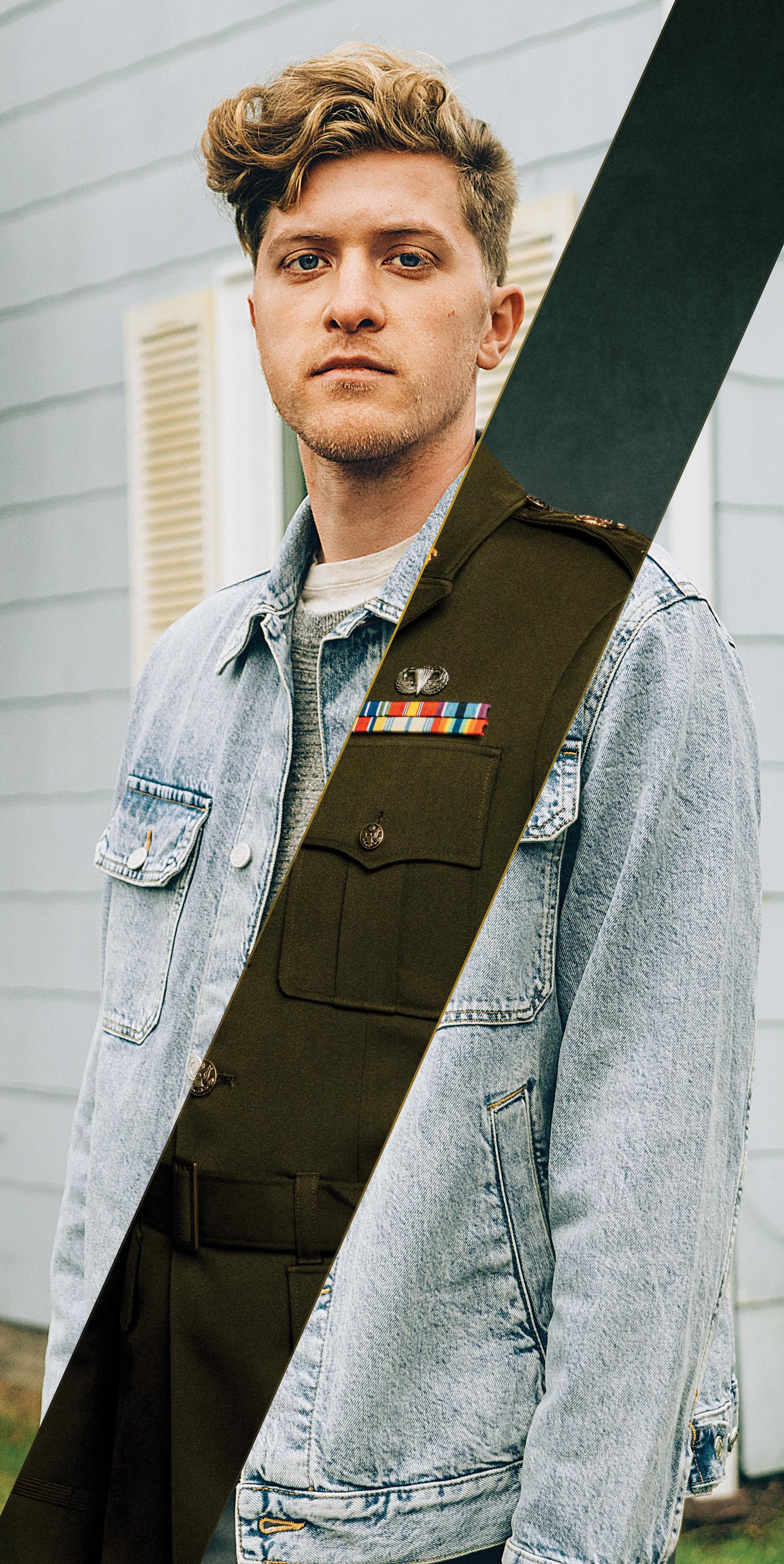







Elise Gottling is a sophomore studying outdoor product design who also loves being behind the camera. When she’s not taking photos, she can be found hiking, enjoying the outdoors or trying to amp up her guitar skills.
— A02386895@usu.edu


Last week’s solution:

www.sudokuoftheday.com.



By Elise Gottling